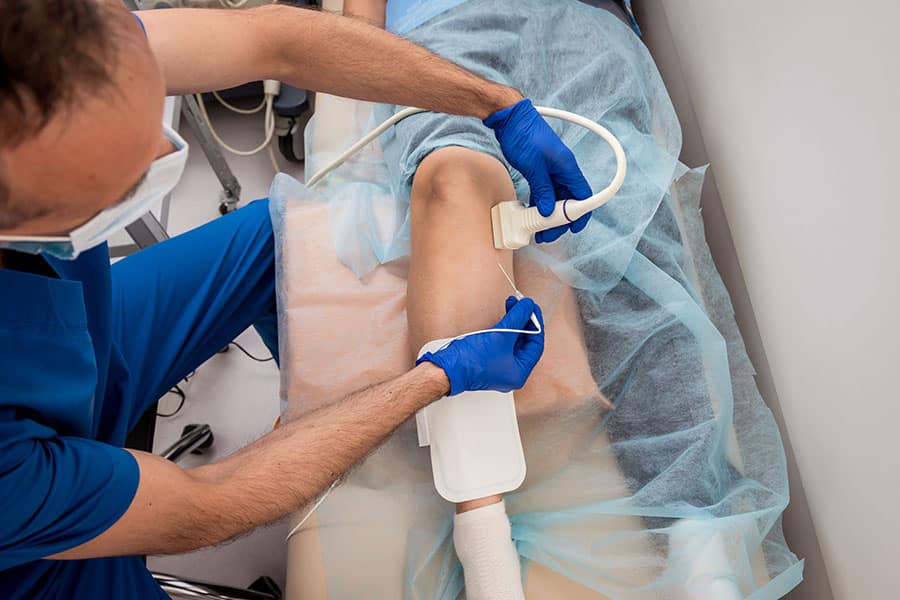Do you have chronic pain in your back, joints, or neck? Radiofrequency ablation may be the best pain management option for you. Read on to learn more about this effective treatment.
What is Radiofrequency Ablation?
Radiofrequency ablation (RFA) is a procedure used to help many people find relief from chronic pain. In most people, it is used to treat arthritis and back and neck pain by providing pain relief, reducing the need for pain medications, and delaying or eliminating the need for surgery. It is minimally invasive and also known as radiofrequency neurotomy.
This procedure destroys nerve tissue with heat put off by radiofrequency waves. This stops pain signals from traveling to the brain. The effectiveness of RFA in providing pain relief is high (over 70%). Depending on the individual, these results can last anywhere from six months to a few years.
Who is a Candidate for RFA?
RFA is often used when other treatment methods have not proved very effective. However, individuals who have received a nerve block injection with some positive results may also be a candidate for this procedure.
What Conditions Can be Treated with RFA?
RFA is used to treat patients who experience long-term pain from arthritis in the joints. This includes conditions such as facet joint degeneration, arthritis of the spine (spondylosis), and sacroiliac joint pain. It is also used to treat lower back and neck pain.
Get Back Your Normal Life Again
As pain specialists, we can guarantee that we are more than qualified in alleviating your pain and treating your condition.
How Does Radiofrequency Ablation Work?
If you are considering RFA for pain management, you may wonder about the procedure. Let’s look at the different steps involved in a successful radiofrequency ablation.
Before RFA Procedure
There are a few steps to take to prepare for this procedure. These can vary for patients who are receiving IV sedation and those who are not. *Please note that the following first two points only pertain to you if you will receive IV sedation for the procedure.
- Refrain from eating six hours before surgery.
- Refrain from drinking clear liquids two hours before surgery.
- Regarding any medicines you take regularly (such as blood thinning medications), your doctor will advise on whether you should take them leading up to and after the procedure.
During RFA Procedure
Once you have arrived and are being prepped for RFA, you may receive an intravenous (IV) line to administer a local anesthetic and mild sedative. These help keep you comfortable, as you will be alert during the procedure.
Your doctor will then locate the general area of pain, insert a small needle, and use X-ray guidance to navigate to the target area and stimulate it with a microelectrode inserted through the needle. To help determine if the needle is in the right place for treatment, your doctor will ask you to notify them if you feel a tingling sensation.
Once your doctor has found the electrode’s proper placement, a small radiofrequency current is sent through the electrode. This radiofrequency causes a small area of the surrounding tissue to heat. The process should not cause any pain or discomfort.
Depending on the treatment location and number of treatments, this procedure can take anywhere from 15 minutes to two hours.
After RFA Procedure
A nurse will keep you under observation in a recovery room after the procedure. They will check your blood pressure and pulse and place a bandage over the injection site to help prevent infection. They will also give you discharge instructions to help you continue your recovery at home. As previously mentioned, you will need someone to drive you home.
You may remove bandages while sleeping and use an ice pack on the injection site a few times each day for 20 minutes.
Is Radiofrequency Ablation Safe?
This treatment has been used to successfully help many individuals dealing with chronic pain. It is proven to be a safe way to help with back, joint, and neck pain with minimal side effects.
RFA Side Effects
The primary side effect that people deal with from RFA is discomfort at the injection site. However, the bruising and swelling should dissipate within days. Other side effects may include leg numbness, mild back discomfort, and in rare cases, nerve damage.
Radiofrequency Ablation Treatment at Arizona Pain and Spine Institute
Are you experiencing chronic back, joint, or neck pain and cannot find relief? Radiofrequency ablation may be the best course of treatment for you. Book an appointment with us at Arizona Pain and Spine Institute to begin your journey to pain relief today!

